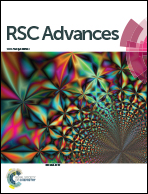A sol–gel derived, copper-doped, titanium dioxide–reduced graphene oxide nanocomposite electrode for the photoelectrocatalytic reduction of CO2 to methanol and formic acid
Abstract
A classic Cu-RGO–TiO2 photoelectrocatalyst was fabricated by a facile sol–gel method, deposited on ITO film via electrophoretic deposition and characterized by XRD, FESEM, UV-Vis and FT-IR spectroscopy. A uniformly distributed porous composite film was observed on the ITO substrate with an average particle size of 18 nm. A lower photoluminescence response of the Cu-RGO–TiO2 sample indicates better electron/hole separation upon irradiation. A maximum 1.31 mA cm−2 photocurrent density was observed at −0.61 V bias potential under solar simulator irradiation during CO2 photoelectrocatalysis. Formic acid and methanol were the main products, but longer reaction times led to increased methanol formation. The estimated current efficiency of the production of formic acid and methanol was 32.47%, and the estimated rates of formation of formic acid and methanol were 255 μmol h−1 cm−2 and 189.06 μmol h−1 cm−2, respectively.


 Please wait while we load your content...
Please wait while we load your content...